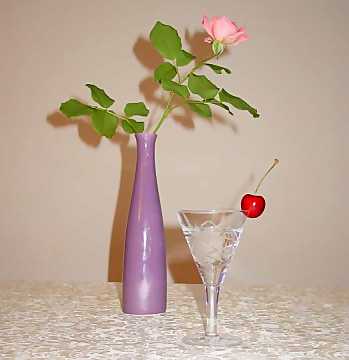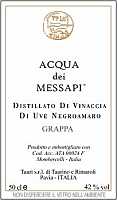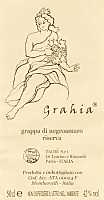|
They were probably Egyptians to make the first rudimentary equipments for
distillation: alembic stills. At those times distillation was mainly used for
the production of essences and also Romans used the same technique for the
production of medicines. Only after many years the distillation process was
used for the production of alcohol. At the end of the Middle Age, in the cities
of Salerno, Toledo and Montpellier were produced the very first rudimentary
alcoholic distillates used for the preparation of flammable liquids. We have to
wait for Theophrast Bombast von Hohenheim in order to read the word alcohol in
the sense we mean today. The distillation process was then elaborated in many
places therefore giving origin to many products, each one having its history
and traditions.
The most used products for the production of brandies certainly were grains,
both because they were locally available, where they were indispensable for the
nutrition of people, and for the availability in markets, as well as for their
relatively convenient price. The most common grain brandies are whisky, whiskey
and vodka. Vodka is most typical Russian brandy known everywhere in the world.
In Russia the origins of vodka are dated back to Peter the Great, despite it is
not the only country to claim the origins of this distillate. Also Poland
claims to be the homeland of vodka, because the history of this distillate in
this country is as ancient as of Russia.
Scandinavians and Slavic people of Northern Europe have taken, since many
centuries, alcoholic beverages very seriously. The logical explanation is
because of the particularly cold climate and this would compromise the
transportation of beverage with low alcohol, such as beer and wine. These
beverages, when transported in wintertime, tended to freeze therefore the
volume increased and the precious load was lost. This contributed to the
spreading of beverage with high percentages of alcohol that were immune to this
problem. Before the spreading of the alembic still, the production of alcoholic
beverages and spirits made use of a stratagem consisting in taking advantage of
cold temperatures. As water freezes at 0°C (32° F) and gets transformed into
ice, whereas alcohol needs lower temperatures in order to freeze, wine, beer or
cider was fermented, and after it was frozen, it was possible to separate
alcohol from water. This certainly was a less refined method, anyway it was a
valid method for those times, even because there was no alternative available.
It seems that in Eastern Europe the first distillate was produced by using beer
and cider and it was called “perevara”. The distillate called “vodka” takes
its name from the water added during its production, in fact in Russian
“voda” means water. In the beginning vodka was prepared for medical
purposes. Slowly distillation procedures become more and more refined and
therefore it was possible to make a product that could be drunk for pleasure
instead because one had to. The term vodka - in Poland known as “wodka” - was
gradually used for identifying the renowned alcoholic beverage. In the
beginning, as the distillation techniques allowed the production of a high
alcoholic liquid, it was used as an ingredient for the preparation of
gunpowder for rifles. Its colorless appearance and its neutral taste made this
product very interesting for Sherry and Porto producers. Thanks to these
characteristics vodka was particularly suited for the fortification of these
extraordinary wines.
|
|  |
| Vodka is frequently used for the
preparation of cocktails and it is appreciated by many as plain |
|
The origin of vodka is, just like the majority of products whose history is
very ancient, uncertain and controverted. One of the countries which claims the
origin of vodka is Poland. The first evidences are dated back to 1300's and
were found near the city of Krakow, however the first written documents are
dated back to 1400's. The progenitor of vodka seems to be okowita,
probably derived from the Latin term aquavitae, used both as a medicine
and a beverage, as well as for other purposes. In 1534 in a book about medicine
it is mentioned vodka used as an after shave lotion, whereas aromatized vodkas
with infusions of officinal herbs were very popular as a remedy for many
diseases - such as depression - as well as for many pains. In 1546 the king
liberalized the production and trading of vodka as well as of the products
connected to this distillate, however the aristocracy insisted in having the
exclusive privilege of producing and selling vodka. From the half of 1800's on,
Polish distilleries were shipping both aromatized and natural vodka in every
country of Northern Europe, including Russia. Currently, after the falling of
communism, distilleries are managed by private companies again which export
quality vodka worldwide.
Even Russia is one of the countries claiming the origin of vodka and Russian
are very convinced about that. Some evidences show the production and trading
of vodka in Russia are dated back around the fourteenth century. In 1540 Zar
Ivan the Terrible established the first State monopoly for vodka while
reserving to nobles the right of distillation. This restriction had the
consequence of the establishment of many clandestine distilleries all over the
country. With time official distilleries began to produce vodka with higher and
higher quality, both natural and aromatized. Even Zars were interested in the
production of this brandy and they built in their palaces experimental
distilleries in order to obtain a product of increasing quality. From the
simple alembic still the production passed to the use of multiple distillations,
until a scientist experimented the filtering by means of vegetal carbon in
order to purify the distilled product.
The production of vodka in Russia was also the origin of a constant growing
both in quantity and, in particular, in quality, also thanks to state
contributions, the inventive of Russians and to alembic stills imported from
Western Europe. Authorities continued to promote the quality of vodka by
financing researches. In 1902 “Vodka Moskovskajia”, a rye vodka with 40% of
alcohol to which was added non distilled and non aromatized water, was decreed
by law as the reference point for the whole Russian production. The production
of Russian vodka reached excellent qualitative levels although the quality
product was only reserved to the higher classes, whereas the common people
could only afford lower quality products. The falling of the wall of Berlin, as
well as the change of the geography and politics in Eastern Europe, did not
change the way vodka is produced. Today in the new Russian Federation, as it
was in Soviet Union and in the pre-revolutionary Russia, quality vodka is
consumed by higher social classes and part is also destined for export,
whereas common people can only afford cheaper brands of mediocre quality.
Talking about the rest of the world, vodka was imported for the first time in
the United States of America in the twentieth century in order to satisfy the
requests of immigrants from Eastern Europe. Besides this particular case, the
selling of vodka in the United States have been scarce for many years and until
the end of World War II. As it may sometimes happens, in order to make a
successful product it only takes an original idea and a proper advertisement
campaign: this is the case of the American market. A merchant of liquors from
South Carolina began to advertise his product by using the slogan “Smirnoff,
the white whisky. No taste. No smell”. The idea was very appreciated as well
as the vodka. The selling increased also thanks to the success of vodka as an
ingredient for many beverages and cocktails. Its characteristics are well
suited to the extravagant blends used in many cocktails all over the world.
Today vodka is the most common white brandy also thanks to its versatility and
the skill of producers and of their successful advertisement campaigns. Having
a good product is not enough, it also takes the capacity of being able to sell
it.
Eastern Europe certainly is the homeland of vodka, however other countries have
developed a technique for the production of spirits as well. Besides historical
vodka producers - such as Russia, Poland, Ukraine, Estonia, Latvia and
Lithuania - there is also Sweden where a vodka of increasing quality is being
produced, both natural and aromatized. Finland, for example, produces vodka
from grains and in particular from wheat. The American production must be, by
law, limited to non aromatized vodka. In Central America local production is
concentrated on molasses vodka, destined to export in order to be blended to
other products. Australia produces a small quantity of vodka and it is almost
destined for domestic consumption. In Asia, with the exception of rather small
places, the best vodkas are the ones produced in Japan.
|





